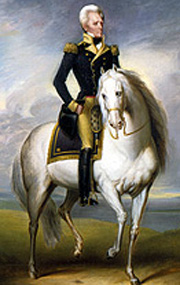 “All persons are requested not to bring their dogs to the field, as they will be shot without respect to the owners.”
“All persons are requested not to bring their dogs to the field, as they will be shot without respect to the owners.”
Things have changed since March 1, 1806, when this notice appeared in Tennessee’s Impartial Review, announcing a match race between Andrew Jackson’s 6-year-old stallion Truxton and Joseph Irwin’s undefeated Ploughboy. The match led to a fatal duel between Jackson and Irwin’s son-in-law, Charles Dickinson, who reportedly provoked the event by making tasteless remarks about Jackson’s wife, Rachel.
The story is recounted in an excellent biography of Jackson, which I recently read – American Lion: Andrew Jackson in the White House by Jon Meachem. The book inspired me to further investigate Jackson and his Thoroughbreds.
“Blooded” horses had been a passion of Jackson’s since boyhood, and as a young lawyer in Nashville, he became known as Tennessee’s leading breeder and owner of racehorses. This was at a time when Tennessee, not Kentucky, was acknowledged as the center for breeding and racing Thoroughbreds (by 1839 there were 10 established tracks in Tennessee).
Jackson, part owner of a track called Clover Bottom, between Nashville and his Hermitage Farm, trained and conditioned many of his own horses, including Virginia-bred Truxton, sired by Diomed, the famous English import inbred to and just three generations removed from the Godolphin Arabian.
As was then the custom, the match between Truxton and Ploughboy was for the best two of three two-mile heats, horse against horse, winner take all of a total $3,000. Ploughboy backers were heartened to learn of swelling in one of Truxton’s back legs, a result of Jackson’s rigorous training program. But neither the sore leg nor a sprung shoe on a front foot prevented the bay stallion from winning the first two matches.
Truxton inherited his stamina and steel from Diomed, the first Epsom Derby winner, who once carrying 168 pounds, won a match that consisted of three four-mile heats. At the age of 21, Diomed was imported to America, where he lived to be 31 and founded a racing dynasty.
Jackson’s favorite personal mount was Sam Patch, a refined gray stallion that he rode during the War of 1812 and the defeat of the British at New Orleans. Sam Patch and Truxton purportedly accompanied Jackson to the White House, after he was elected president in 1828.
After serving two terms at President, Jackson retired to the Hermitage in 1837. He died in 1845, at 78, still carrying a bullet lodged close to his heart from the duel with Charles Dickinson.
